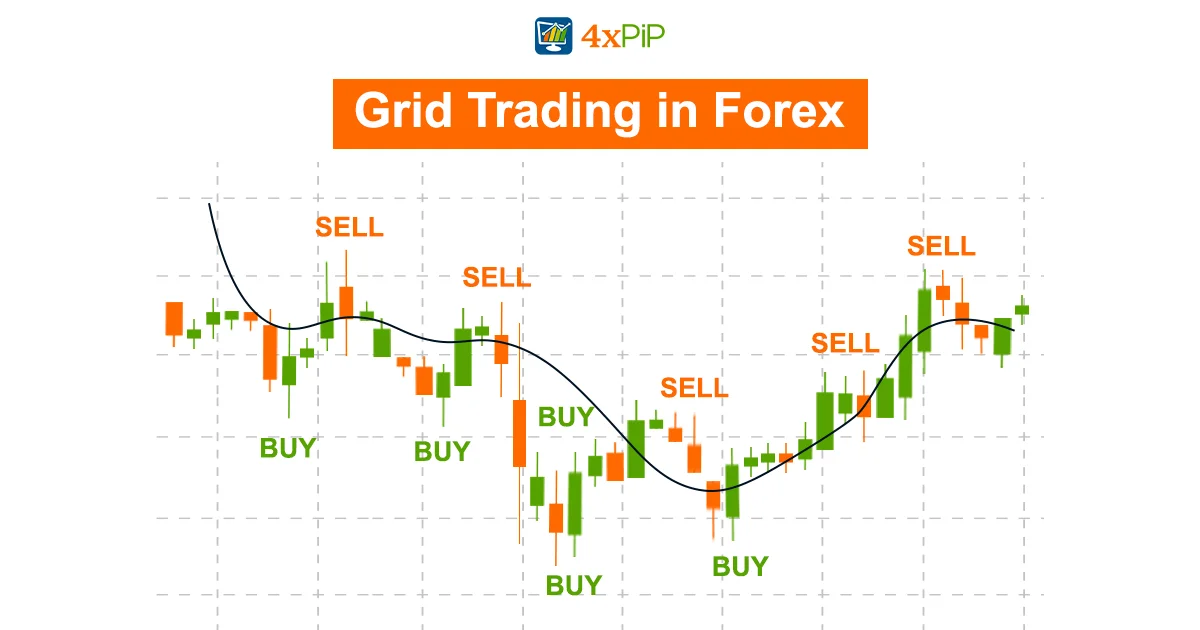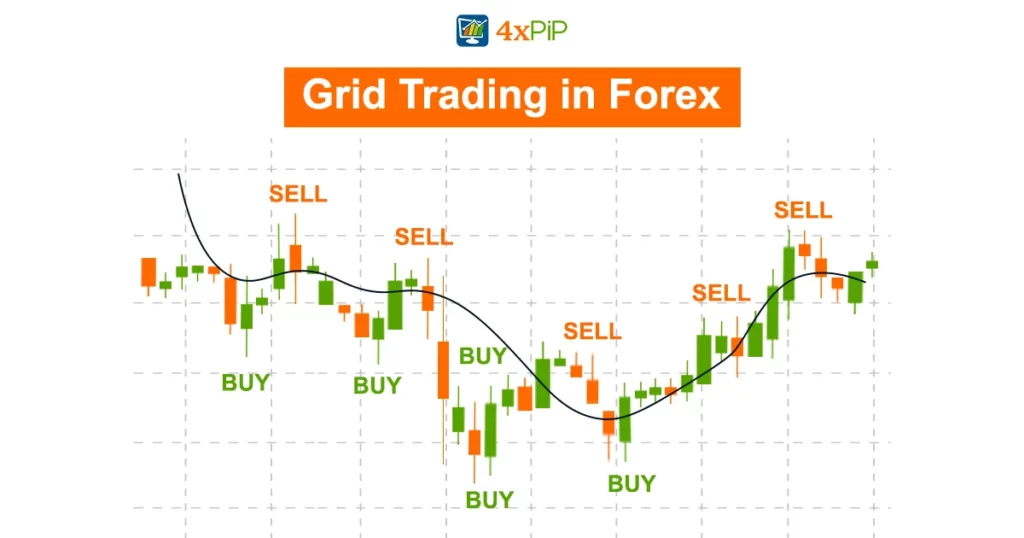Grid trading is a popular strategy in the world of trading, be it in the cryptocurrency market, forex, or stocks. It’s a technique employed by both day traders and swing traders. In this article, we’ll look into the concept of grid trading and provide valuable insights for traders at all levels. At 4xPip, we’re committed to offering beginners a comprehensive understanding of grid trading strategies. Also, our experts are here to guide you, and we also provide trading tools and robots for automated trading. Don’t miss out on this essential information.
Understanding Grid Trading:
Grid trading is a dynamic strategy employed by traders in various financial markets. This technique involves setting up a network of buy and sell orders at predefined intervals above and below the current market price. The primary goal of grid trading is to capture price fluctuations as the market oscillates within a specified range. It’s important to note that grid trading is not a one-size-fits-all approach and requires careful planning, risk management, and adaptability to changing market conditions. In this article, we’ll delve into the fundamentals of grid trading, discuss its suitability for different traders, and explore how this strategy can be harnessed effectively in a variety of market environments. Moreover, whether you’re a day trader or a swing trader, understanding grid trading can be a valuable addition to your trading repertoire.
What is Grid Trading:
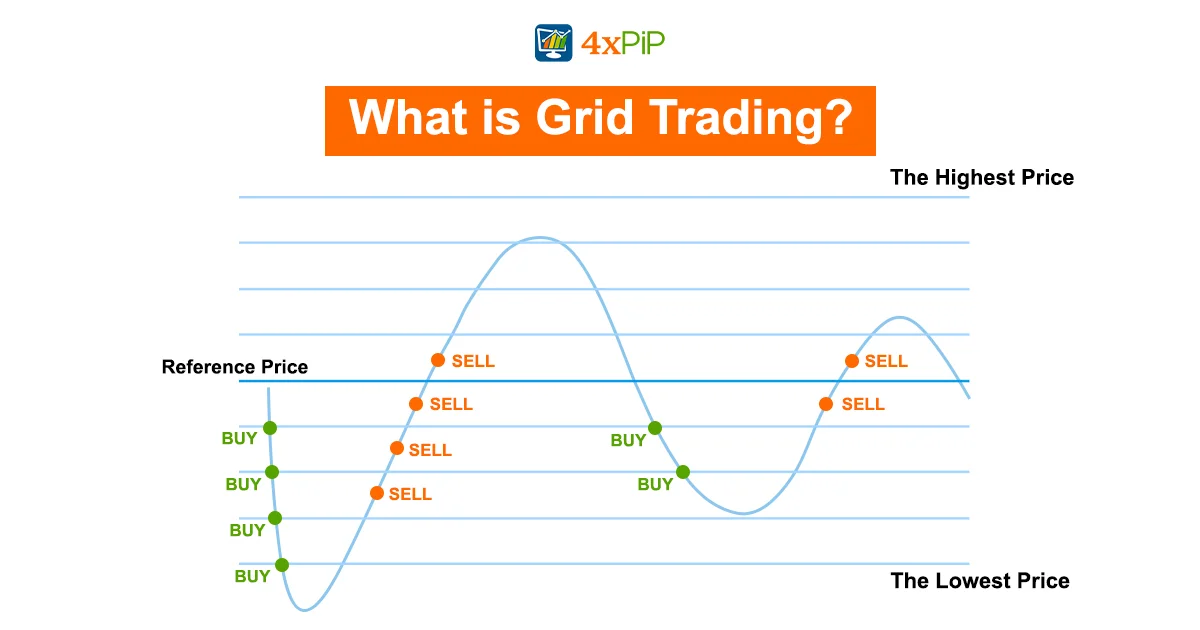
Grid trading is a popular strategy in the world of trading, utilized by both novice and experienced traders in various financial markets, including cryptocurrency, forex, and stocks. At its core, grid trading is a systematic approach that involves creating a grid or network of buy and sell orders to capitalize on market fluctuations. Here are the fundamental concepts of grid trading:
- Grid Structure: Grid trading employs a series of limit orders placed at regular intervals above and below the current market price. These orders create a grid, which is essentially a set of buy and sell levels.
- Range-Bound Strategy: This strategy is most effective in markets that exhibit a sideways or range-bound movement. Traders aim to profit from price oscillations within a specified range.
- Diversified Approach: Grid trading allows traders to diversify their positions by having multiple buy and sell orders in place, capturing gains as the market moves up and down.
- Risk Mitigation: Grid trading emphasizes risk management by setting stop-loss orders to limit potential losses. The goal is to minimize risk while maximizing gains.
- Automated Solutions: Many traders employ Expert Advisors (EAs) or autotrading robots to execute grid trading strategies automatically. These tools can help streamline the process and reduce the need for constant monitoring.
Furthermore, grid trading can be a powerful tool when applied correctly, but it’s essential to understand the market conditions and the specific risks associated with this strategy. To get started with grid trading and gain a deeper understanding of how to minimize risks and maximize profits, reach out to 4xPip’s experts, or explore their range of products and automation solutions. Remember, knowledge and guidance are key when venturing into the exciting world of grid trading.
Tips for Building a Grid Trading System:
Grid trading can be an effective approach for traders to profit from price volatility while managing risk. Here’s a breakdown of a profitable grid trading strategy:
- Grid Setup: Start by defining a grid with a series of buy and sell orders at preset intervals. The grid typically consists of both buy (long) and sell (short) orders placed above and below the current market price.
- Grid Spacing: The spacing between orders is a crucial aspect of the strategy. Traders should determine the distance between buy and sell orders based on market conditions, asset volatility, and personal risk tolerance.
- Range-Bound Markets: Grid trading is most profitable in range-bound or sideways markets. It relies on the assumption that prices will oscillate within a specified range over time.
- Buy Low, Sell High: As the market fluctuates, the strategy allows you to buy low when the price drops and sell high when it rises. This “buy low, sell high” approach can lead to consistent profits.
- Risk Management: To minimize risk, it’s essential to set stop-loss orders at appropriate levels. If the market moves against your grid, these stop-loss orders will limit potential losses.
- Continuous Monitoring: While grid trading can be automated, regular monitoring of the market is crucial. Traders need to adjust the grid parameters as market conditions change.
- Profit Realization: Grid trading aims to capitalize on small price movements, accumulating gains over time. It’s not about making significant profits in a single trade but rather generating consistent returns.
- Combining Indicators: Many traders use technical indicators or fundamental analysis to help identify entry and exit points for their grid orders. These tools can enhance the strategy’s effectiveness.
Moreover, remember that grid trading is not a guaranteed profit strategy, and it comes with its own set of risks. Market conditions can change rapidly, and the strategy may require adjustments to remain profitable. Additionally, it’s crucial to determine your risk tolerance and employ proper risk management techniques to protect your capital. If you’re new to grid trading or looking to optimize your strategy, consider seeking advice and guidance from the 4xpip trading experts or exploring trading tools that can automate the process.
Creating a Grid Trading Strategy:
To harness the potential of grid trading effectively, traders need to carefully construct their trading grid. Whether you opt for a with-the-trend or against-the-trend approach, here are the essential steps to build a successful grid trading strategy:
Step 1: Choose an Interval
Begin by selecting an interval that suits your trading objectives and market conditions. Common intervals include 10 pips, 50 pips, or 100 pips. This interval will determine the spacing between your buy and sell orders within the grid.
Step 2: Set a Starting Price
Next, pinpoint the starting price for your grid. This price acts as your anchor, and all other orders will be placed relative to it. For instance, you might choose a starting price of 1.1550 in your trading grid.
Step 3: Decide on the Grid Direction
Grid trading can be executed in two primary directions: with-the-trend or against-the-trend. Your choice depends on your market analysis and trading preferences.
With-the-Trend Grid:
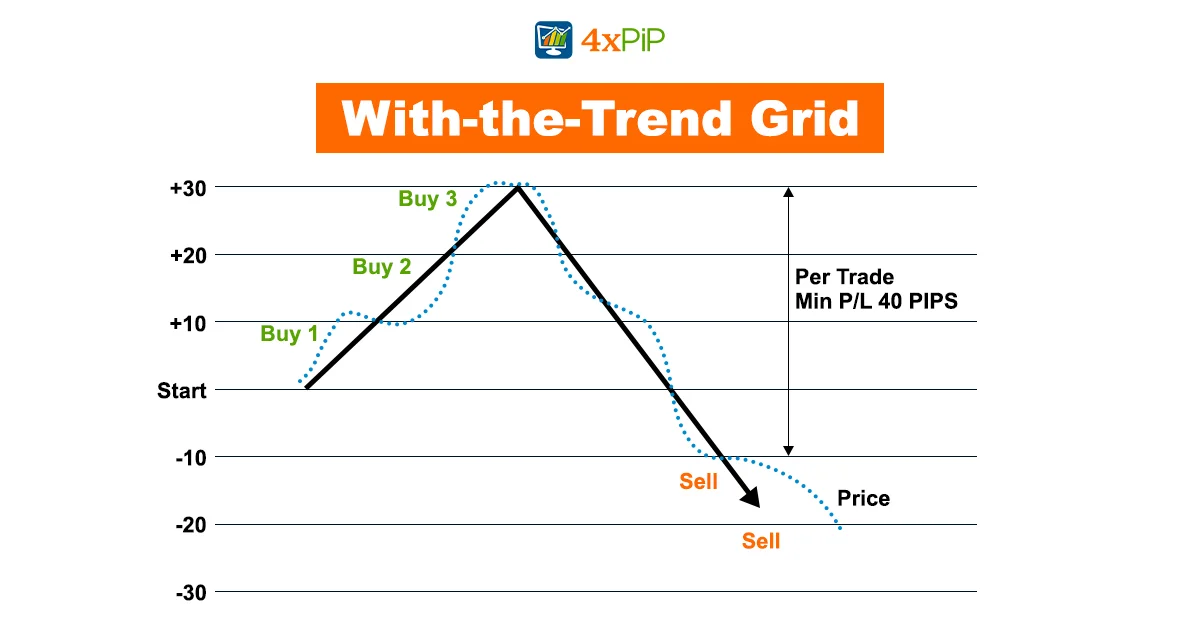
In this approach, you align your grid with the current market trend. For example, if the starting point is 1.1550 and you’ve chosen a 10-pip interval, place buy orders at 1.1560, 1.1570, 1.1580, 1.1590, and 1.1600. Simultaneously, position sell orders at 1.1540, 1.1530, 1.1520, 1.1510, and 1.1500.
Also, remember that this strategy requires vigilance and an exit plan to lock in profits when the market is moving favorably.
Against-the-Trend Grid:
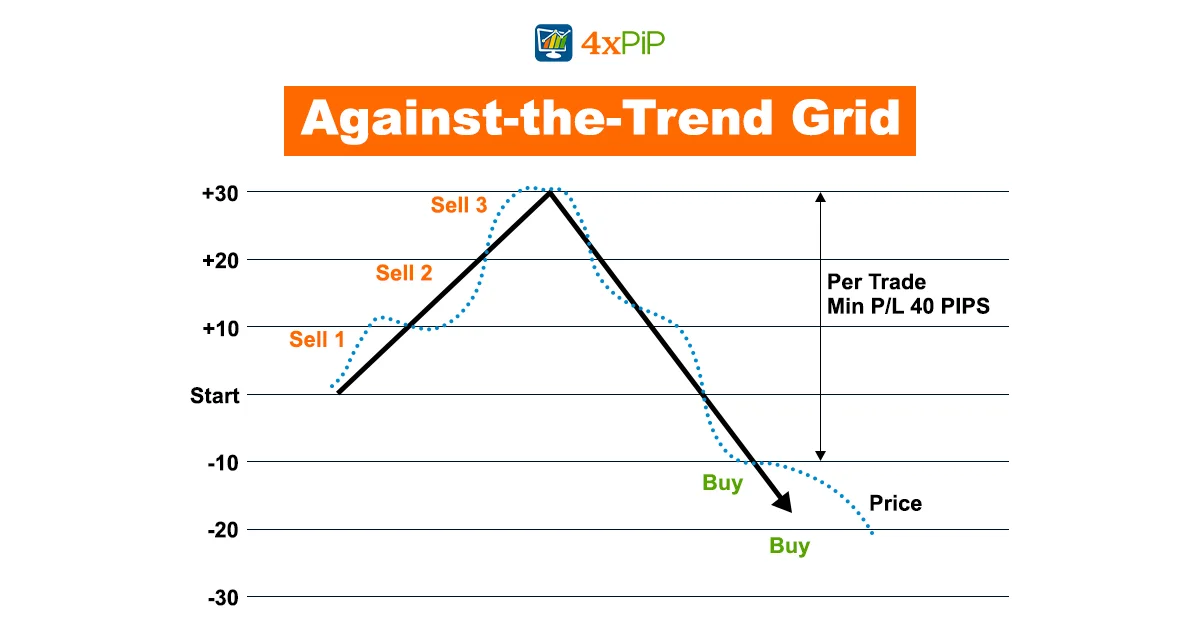
In contrast, an against-the-trend grid is designed to capture price reversals. Using the same starting point of 1.1550 and a 10-pip interval, place buy orders at 1.1540, 1.1530, 1.1520, 1.1510, and 1.1500. Concurrently, position sell orders at 1.1560, 1.1570, 1.1580, 1.1590, and 1.1600.
This approach is inherently riskier, and it’s essential to implement stop-loss orders to limit potential losses if the price moves significantly in one direction. Remember that market conditions, asset volatility, and risk tolerance will influence your choices in interval, direction, and starting price.
Moreover, if you require further guidance, consider reaching out 4xpip experts at [email protected] and we will guide you.
Grid Trading Example for GBPUSD:
Grid trading comes to life when applied in a real-world scenario, and what better way to understand it than through an example in the popular GBP/USD forex market. Let’s look into how a grid trading strategy might look for this particular currency pair.
Imagine you’re a forex trader, and the GBP/USD currency pair is currently trading at 1.3200. You decide to employ a grid trading strategy with a 20-pip interval, creating a grid that includes both buy and sell orders. To keep it simple, let’s focus on a with-the-trend grid. Your first buy order is placed at 1.3220, and you continue with additional buy orders at 1.3240, 1.3260, and so on, at 20-pip intervals. Simultaneously, sell orders are positioned below the starting price at 1.3180, 1.3160, 1.3140, and so forth. The grid is ready to capture price fluctuations within this predefined range.
As the market unfolds, price movements oscillate. Let’s say the GBP/USD rises from 1.3200 to 1.3250. The buy order at 1.3220 executes, capturing a profit of 30 pips as the grid strategy kicks in. Meanwhile, your sell order at 1.3180 remains untouched. However, a well-executed grid strategy requires vigilance. If the market continues to move in your favor, you’ll need an exit plan to lock in your profits, as holding onto the grid indefinitely isn’t advisable.
Grid trading carries its risks. If the market undergoes a sudden and significant move in one direction, it could trigger a series of sell or buy orders, potentially resulting in substantial losses. That’s why effective risk management is crucial. Many traders employ stop-loss orders to limit potential downside. Additionally, it’s essential to adapt your grid to changing market conditions. Grid trading is a dynamic strategy, and you may need to adjust your grid parameters or even switch from a with-the-trend to an against-the-trend grid when the market trend changes.
This example of grid trading in GBP/USD showcases how traders can use this strategy to capitalize on price fluctuations while managing risk. Keep in mind that grid trading requires constant monitoring, risk management, and adaptability to evolving market conditions. It’s an approach that suits specific market environments and trading preferences, making it a valuable tool when used effectively.
Summary:
Grid trading is a great strategy employed by traders across cryptocurrency, forex, and stock markets. Whether you’re a day trader or a swing trader, the concept of grid trading can be a valuable addition to your trading toolbox. In this approach, traders set up a network of buy and sell orders at predefined intervals, designed to capture price fluctuations. Having explored the fundamental principles of grid trading, including grid structure, the suitability of range-bound markets, diversified approaches, and the importance of risk mitigation, it’s worth noting that grid trading isn’t without risks. Moreover, traders must stay vigilant, adapt to changing market conditions, and employ risk management techniques for a successful grid trading journey.
Furthermore, to provide a real-world perspective on grid trading, we examined a scenario in the GBP/USD forex market. The example illustrated how traders can implement grid trading with a 20-pip interval, both with and against the market trend. Also, the key takeaways emphasize the importance of consistent monitoring, risk management, and the need for an exit plan to secure profits. Overall, grid trading can be a dynamic and powerful strategy when used effectively, catering to specific market conditions and individual trading preferences.

